About the Church
 |
 |
 |
 |
 |
 |
 |
The Symbolism of the Papal Red & White
As it was widely reported by the BBC, after Pope Francis was elected he turned down the red cape with ermine, saying, “No thank you, Monsignor. You put it on, instead. Carnival time is over!”
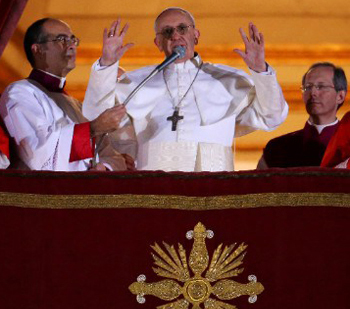 The Vatican said it could not confirm or deny the report, which is already a half-confirmation. But whether Francis said those words or not, the fact remains that he turned down the traditional red cape and made his first appearance before the people in just the white cassock.
The Vatican said it could not confirm or deny the report, which is already a half-confirmation. But whether Francis said those words or not, the fact remains that he turned down the traditional red cape and made his first appearance before the people in just the white cassock.
Many persons assumed this was just a personal whim of the new Pope, “no big deal” to make a fuss about. I do not think they realize the symbolism of the red cope, which goes back for many centuries. Both the red mantle and the white cassock have an important significance regarding the understanding and function of the Papacy.
Meaning of the red mantle
Already in the 11th century St. Peter Damian described the cappa rubea donned by the Pope at his election as a distinctive garb unique to the Pope. (1) Because it stood for the supremacy of the spiritual sphere over the temporal, St. Gregory VII (1073–1085) warned that “only the Pope may use the red cape as a sign of imperial authority and martyrdom.”(2)
According to tradition, that cape derived from the clamide purpurea, a large cloak worn over the shoulders that was part of the insignia granted to the Pope in the Donation of Constantine. Therefore, it signified the temporal as well as spiritual authority the Pope had over the Papal States.
During the medieval period wearing the red papal mantle signified the papal office. To take on the cloak of imperial red was a sign of the dual identity of the new Pope: “a royal Priest and an imperial Bishop.” (3) This is why the anti-pope Victor IV tried to seize the mantle - and thus the papacy - from Alexander III at the conclave of 1159.
As the reader can see, donning the red cape after the election is not just a quirk to follow or not follow. It is a highly symbolic act that stands for the Pope assuming the full authority of his office. When Francis refused to don it, he was in effect rejecting the temporal authority that accompanies the spiritual office, as well denying the imperial or royal character of the Papacy. It seems likely that in fact he was referring to this when he emphasized, “The carnival is over.”
The Pope in white is not an invention of St. Pius V
To justify Pope Francis’ desire to deprive himself of the traditional papal red cope, some commentators are pointing to St. Pius V (1566-1572) as being likewise innovative after his election.
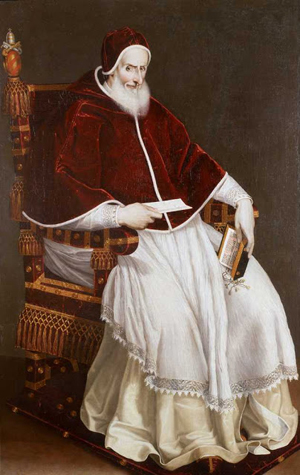 According to this legend, St. Pius V, a Dominican, chose to wear his same white Dominican habit and thus introduced the custom of the Pope wearing white. Now, if St. Pius V decided to be original, the new Pope’s defenders say, then who can deny the same prerogative to Francis?
According to this legend, St. Pius V, a Dominican, chose to wear his same white Dominican habit and thus introduced the custom of the Pope wearing white. Now, if St. Pius V decided to be original, the new Pope’s defenders say, then who can deny the same prerogative to Francis?
This legend, however, is not accurate. We know from early ceremonial books that the Pope dressed in white and red centuries before Pius V. The first formal record we have of the Pope’s dress being white is in the Ordo, or ceremonial book, of Pope Gregory X (1272-1273), almost three centuries before Pius V.
It describes the red cope and white garments (alba Romana) as standing for the Pope’s universal power over the Church and his temporal power over the Papal States: the red symbolizing the former, and the white, the latter. The two colors also represented Christ as they were “symbols of martyrdom and divinity.” (4)
Another formal description of the Pope in white – reported as if it were already a longstanding tradition - is found in the Rationale Divinorum Officiorum (1286) of Guillaume Durand. Explaining the symbolic meaning of the papal robes, the 13th century Dominican states:
"The Supreme Pontiff always appears wearing a red mantle on the outside; but underneath he is dressed in a bright white garment. For whiteness symbolizes innocence, and the red on the outside symbolizes charity and compassion, that is to say, to show that he is always ready to lay down his life for his sheep because, indeed, the Pope represents the person of the One who, for our sake, stained his own garment red.” (5)
Durand’s statement was reaffirmed by Patrizio Piccolomini who, in his ceremonial book of 1484-1492, stressed that the Pope always wore white or red, even in his clothing that is not sacred. Thus the introduction of the papal red shoes, also abandoned by Francis… (6)
We are told that when Pius II was elected in 1458 – a century before Pius V was chosen – “he cast off his old garments and put on the white tunic of Christ.” (7) From this it is clear that the custom of the Pope wearing white was in place long before the election of Pius V in 1566.
In the pictures below you can see a brief iconographic history of Popes before St. Pius V wearing white, amassed by Francesco Colafemmina on the website Fides and Forma
No, St. Pius V did not make a ceremonial innovation after his election. Yes, Francis did, and the act had meaning.
Since the donning of the red is an important sign of the Pope's spiritual and temporal powers over the Universal Church, the refusal of Francis to don that symbolic cope signifies something more than a personal preference. It is a symbolic denial of the papal role.
At least one journalist got this symbolism right. In the Corriere Della Sera, Italian editorialist Massimo Franco said this about the action of Francis refusing the cope: "The era of the Pope-King and of the Vatican court is over."
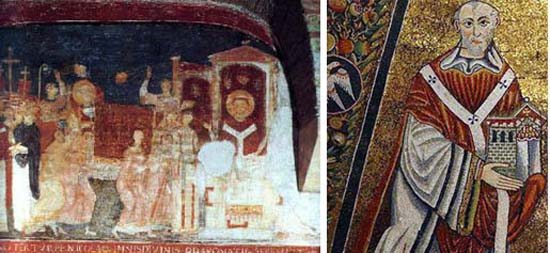
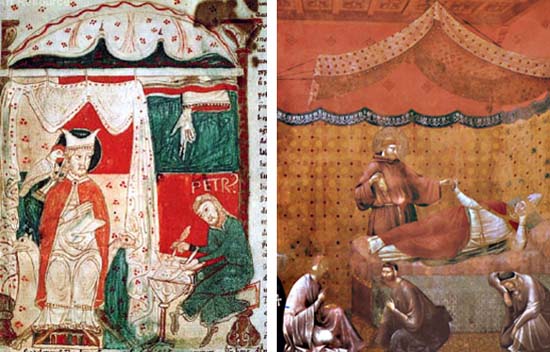
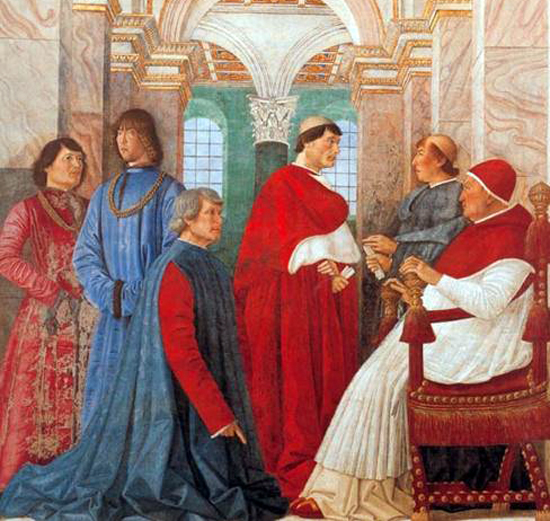


Pope Francis refuses the red cope: "The carnival is over"
Many persons assumed this was just a personal whim of the new Pope, “no big deal” to make a fuss about. I do not think they realize the symbolism of the red cope, which goes back for many centuries. Both the red mantle and the white cassock have an important significance regarding the understanding and function of the Papacy.
Meaning of the red mantle
Already in the 11th century St. Peter Damian described the cappa rubea donned by the Pope at his election as a distinctive garb unique to the Pope. (1) Because it stood for the supremacy of the spiritual sphere over the temporal, St. Gregory VII (1073–1085) warned that “only the Pope may use the red cape as a sign of imperial authority and martyrdom.”(2)
According to tradition, that cape derived from the clamide purpurea, a large cloak worn over the shoulders that was part of the insignia granted to the Pope in the Donation of Constantine. Therefore, it signified the temporal as well as spiritual authority the Pope had over the Papal States.
During the medieval period wearing the red papal mantle signified the papal office. To take on the cloak of imperial red was a sign of the dual identity of the new Pope: “a royal Priest and an imperial Bishop.” (3) This is why the anti-pope Victor IV tried to seize the mantle - and thus the papacy - from Alexander III at the conclave of 1159.
As the reader can see, donning the red cape after the election is not just a quirk to follow or not follow. It is a highly symbolic act that stands for the Pope assuming the full authority of his office. When Francis refused to don it, he was in effect rejecting the temporal authority that accompanies the spiritual office, as well denying the imperial or royal character of the Papacy. It seems likely that in fact he was referring to this when he emphasized, “The carnival is over.”
The Pope in white is not an invention of St. Pius V
To justify Pope Francis’ desire to deprive himself of the traditional papal red cope, some commentators are pointing to St. Pius V (1566-1572) as being likewise innovative after his election.

Pope Pius V - not the first to wear the white cassock
This legend, however, is not accurate. We know from early ceremonial books that the Pope dressed in white and red centuries before Pius V. The first formal record we have of the Pope’s dress being white is in the Ordo, or ceremonial book, of Pope Gregory X (1272-1273), almost three centuries before Pius V.
It describes the red cope and white garments (alba Romana) as standing for the Pope’s universal power over the Church and his temporal power over the Papal States: the red symbolizing the former, and the white, the latter. The two colors also represented Christ as they were “symbols of martyrdom and divinity.” (4)
Another formal description of the Pope in white – reported as if it were already a longstanding tradition - is found in the Rationale Divinorum Officiorum (1286) of Guillaume Durand. Explaining the symbolic meaning of the papal robes, the 13th century Dominican states:
"The Supreme Pontiff always appears wearing a red mantle on the outside; but underneath he is dressed in a bright white garment. For whiteness symbolizes innocence, and the red on the outside symbolizes charity and compassion, that is to say, to show that he is always ready to lay down his life for his sheep because, indeed, the Pope represents the person of the One who, for our sake, stained his own garment red.” (5)
Durand’s statement was reaffirmed by Patrizio Piccolomini who, in his ceremonial book of 1484-1492, stressed that the Pope always wore white or red, even in his clothing that is not sacred. Thus the introduction of the papal red shoes, also abandoned by Francis… (6)
We are told that when Pius II was elected in 1458 – a century before Pius V was chosen – “he cast off his old garments and put on the white tunic of Christ.” (7) From this it is clear that the custom of the Pope wearing white was in place long before the election of Pius V in 1566.
In the pictures below you can see a brief iconographic history of Popes before St. Pius V wearing white, amassed by Francesco Colafemmina on the website Fides and Forma
No, St. Pius V did not make a ceremonial innovation after his election. Yes, Francis did, and the act had meaning.
Since the donning of the red is an important sign of the Pope's spiritual and temporal powers over the Universal Church, the refusal of Francis to don that symbolic cope signifies something more than a personal preference. It is a symbolic denial of the papal role.
At least one journalist got this symbolism right. In the Corriere Della Sera, Italian editorialist Massimo Franco said this about the action of Francis refusing the cope: "The era of the Pope-King and of the Vatican court is over."

Above left, an 11th century painting of Nicolas II, right, a mosaic of Innocent II, c. 1140

Above left, St. Gregory the Great pictured in the 12th c; right, Gregory IX painted by Giotto in the 14th c.;Below, Boniface VIII depicted in red and white in a 14th c. manuscript
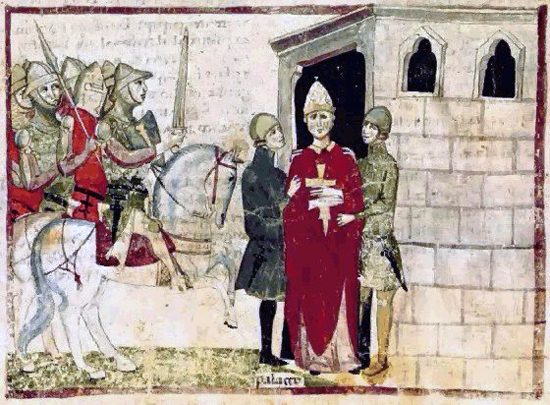
Below, Sistus IV, Vatican Collection, painted in a 1477 manuscript

- Peter Damian, Epist., book 1, 20 (1073) in Carol M Richardson, The Cardinal’s Red Hat, The Open University, UK, p. 6
- “Descriptio sanctuarii Lateranensis ecclesiae”, in ibid., p. 7.
- Paravicini-Bagliani, The Pope’s Body, in ibid., p. 5.
- Liber III, Chapter XIX, in ibid., p. 5.
- Pius II, Commentaries, vol.1, 198–99, in ibid.
- Dykmans, L’Oeuvre de Patrizi Piccolomini, in ibid.

Posted May 22, 2013











